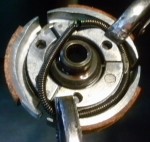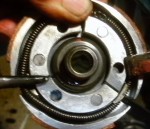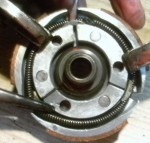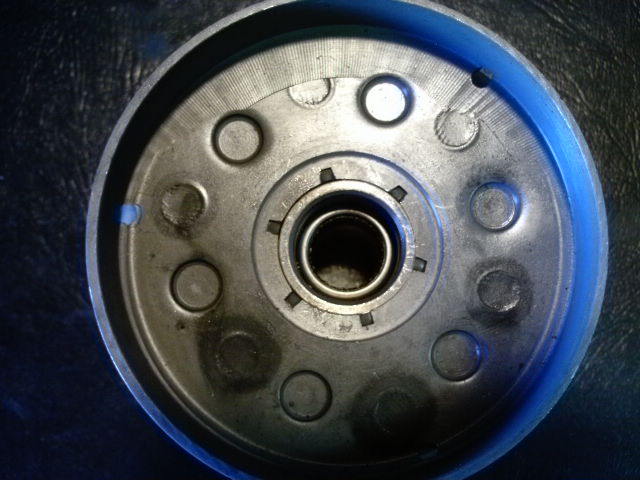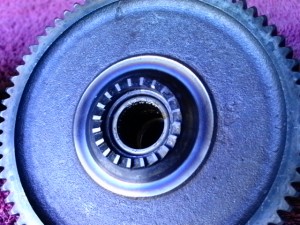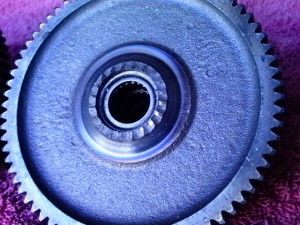Basic A35/A55 Transmission Service
Replacing the first speed clutch segments:
1. Once the transmission oil is drained out, and the trans cover removed, the clutch and trans are exposed.
2. The 17mm clutch nut is spun off with an impact wrench. The outer first speed clutch just pulls straight out.
3. The circular coil spring is removed. The old clutch segments are removed, preserving the orientation.
4. The new clutch segments are transferred over one at a time so as to not scramble the direction.
5. The three leaf springs are put back, with tails inside, not outside the neighbor spring’s cradle.
6. The circular coil spring is carefully stretched and maneuvered into position. See photos below.
Step 6a. Getting everything ready for the spring pre-loading (stretching).
At the gaps between the segments, the leaf springs have “cradles”. These cradles prevent the spring from wandering either way and coming off. When installing, always put the c-clamps or vise grips where you can almost get two of the three cradles. Never clamp onto the spring or the brake lining. Left, initially set the clamps like this. There’s no tension in the spring yet.
>
>
Step 6b. Gently stretch with soft thumbs then clamp it
Now with both your thumbs, gently stretch and lift the spring onto the ledge, but not yet over the cradle. You cannot let go or it will come off and maybe fly away. Hopefully you have a third needle nose vise grips within arms reach that is already adjusted and ready to clamp. Without letting the spring snap back and without taking too much time, clamp the third vise grips (a needle nose vice grips like shown here is best) to prevent the spring from flying off.
>
Step 6c. Gently pry the spring over the cradle with a small screwdriver
Just like putting a tire onto a rim, that last little bit is the most difficult. It’s very easy to damage the spring by forcing it to go when it doesn’t want to. If it gets tight, release and try to take a smaller bite. If the new spring is over stretched by rough handling during installation, it will be like having an old softer one.
>
>
7. Once it snaps over the cradle you got it. Now just push on it to snap it in it’s groove all around.
8. Place the assembled 1st speed clutch back on, tighten the nut with the impact.
9. Put the two rear shaft’s shim washers 10 & 16mm in place, clean the gasket surfaces and any sludge.
9a. For Pedal Models: Take the left pedal crank off, or at least park the pedal in the down position. The weight of that far side pedal makes the pedal shaft point wrong, causing the transmission cover to not go on right.
9b. For Pedal Models: Make sure the U-shaped clip is in it’s slot in the case wall. The starter (pedal) shaft should move 45 degrees back and forth. If only the clutches were removed, and not the countershaft and pedal shaft assemblies, then it will still be in it’s slot, ready for the trans cover to go back on. More pictures of this will be put here soon …
10. Put the trans cover on. When everything is aligned, it makes a loud clap.
11. Then tighten the trans cover bolts. Put new ATF fluid and go try it out!
